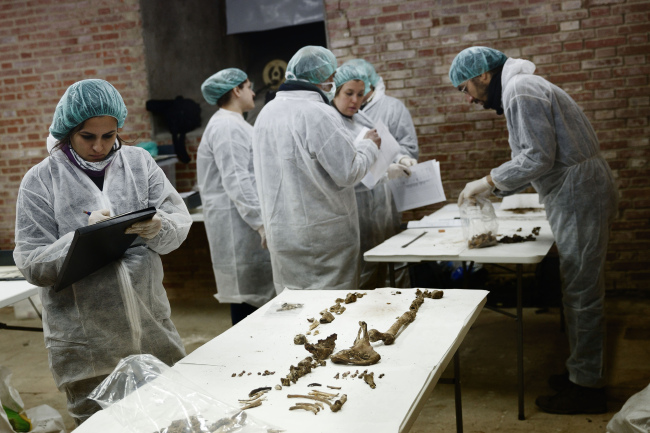MADRID (AP) ― Forensic experts began excavating graves and examining bones Saturday in a tiny chapel in Madrid, hoping to solve the centuries-old mystery of exactly where the great Spanish writer Miguel de Cervantes was laid to rest.
The author of “Don Quixote” was buried in 1616 at the Convent of the Barefoot Trinitarians in Madrid’s historic Barrio de las Letras, or Literary Quarter, but the exact whereabouts of his grave within the convent chapel are unknown.
A team of archaeologists and anthropologists decided to start excavations at the site after identifying what they believe are three unrecorded and unidentified graves in the chapel’s crypt.
Cervantes is a towering figure in Spanish culture. His novel ― “The Adventures of the Ingenious Nobleman Don Quixote of La Mancha” ― changed Spanish literature. His wife, Catalina Salazar, was also buried at the convent, although the location of her grave also remains a mystery.
On Saturday, the chapel crypt had the air of a modern forensic laboratory transported to a medieval location, with more than 20 experts at work with white lights under a vaulted ceiling.
By midmorning, some experts were examining bones that had been extracted from a niche and carefully laid out on a table. Another group of five white-clad experts painstakingly opened a grave beneath the whitewashed crypt’s old terracotta-tiled floor.
 |
A team of archaeologists and anthropologists take notes after starting the excavation work after identifying three unrecorded and unidentified graves in the chapel’s crypt of the closed order Convent of the Barefoot Trinitarians in Madrid’s historic Barrio de las Letras, or Literary Quarter, Spain, Jan. 24, 2015. (AP-Yonhap) |
Close to the crypt’s entrance, two scientists studied images obtained from within another wall niche by using an endoscope camera carefully inserted through a tiny hole.
Elsewhere, a team assembled a geo-radar device mounted on wheels to probe other possible underground locations.
“Were we to find remains that fulfill the characteristics we are looking for, we could possibly pass to the next stage. That would be to compare DNA similarities with his sister, but that is a very complex step,” said Francisco Etxeberria, a forensic medicine specialist from the University of the Basque Country.
The author’s sister, Luisa de Cervantes, was buried in a convent in Alcala de Henares, 30 kilometers east of Madrid, where she was interred in 1623.
Almudena Garcia Rubio, who is leading the Cervantes project, said Friday if they don’t find Cervantes’ remains in the places so far identified, there are four other possible locations at the convent they could try next.
Evidence marking the location of Cervantes’ grave is believed to have been lost during an enlargement of the church after his death. Back in Cervantes’ day, graves were not often marked with long-lasting memorials such as carved headstones, Etxeberria said.
Before settling down to work, the forensic team had to shift piles of old books and bookcases from the space, which had previously been rented out to a publishing company.
The first phase of the excavation, costing some 50,000 euros ($56,000), is expected to last two weeks.








![[Weekender] Korea's traditional sauce culture gains global recognition](http://res.heraldm.com/phpwas/restmb_idxmake.php?idx=644&simg=/content/image/2024/11/21/20241121050153_0.jpg)